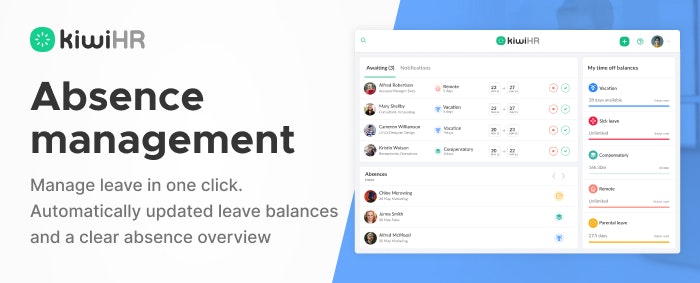- Leave Management
Why your company should grant and embrace paternity leave

Paternity leave is designed to be taken in one framework of time right after the birth of a child. But sometimes companies offer paternity leave to the father or both parents sometime during the child's first year. Read on and learn more about the benefits of adopting a flexible paternity leave policy so your company can reap the benefits.
Despite the benefits of offering paternity leave, the Trades Union Congress (TUC) reports that in the U.K., two in five fathers who work aren't eligible for paternity leave. Most of the time, the fathers aren't qualified because their partner isn't in paid employee work. That loophole is how many U.K. companies get away with not offering paternity leave.
That is disconcerting to discover because, in 2020, many countries offer their workers a fair and reasonable paternity leave policy. In the U.K. to be eligible for paternity leave you must:
- be the biological father of the child or the partner of the mother of the child
- be committed to taking responsibility for the child's upbringing
- worked for your employer for at least 26 weeks by the end of the 15th week before the baby's due date
- be employed by the same employer on the day the baby is born

Understanding what are the paternity leave requirements in the U.K.
Many companies understand they must comply with regulatory paternity leave minimums from a legal standpoint. But some companies are also complying with above and beyond minimum standards because it helps them retain employees. It's important to understand the definition of paternity leave whether you’re setting your companies paternity policies or are an employee that’s becoming a new dad.
U.K.'s paternity leave requirement can be best understood by reviewing the maternity/paternity model the U.K. has had in place since 2015. Before 2015, it was only the mother who had the option to take paid time off from work to look after her newborn. In 2015 a new law was passed in which both parents might be able to get Shared Parental Leave (SPL).
Statutory Shared Paternity Pay (ShPP) applies to couples, whether they are:
- having a baby
- adopting a child
- having a baby through a surrogacy agreement.
But SPL and ShPP have eligibility criteria they must meet.
Paternity leave in the UK - statutory entitlement
The law states that parents are statutorily entitled to one or two consecutive weeks of maternity, paternity, or a combination of maternity and paternity leave taken together. The statutory entitlement does not apply before your baby's birth and officially begins on the day the baby is born. The statutory entitlement can even apply to an agreed-upon number of days after the expected week of childbirth. This comes in handy if you go past your due date or you're adopting.
The parental leave must be complete within 56 days of the birth or due date should the baby come early. You can share up to fifty weeks of leave and thirty-seven weeks of pay with your partner. Shared parental leave is paid for only thirty-seven weeks, with the remaining thirteen weeks being unpaid.
Bereavement leave for parents
2020 has been the year of change. In the U.K., bereavement leave for parents went into effect on April 6, 2020. It's called Jack's Law and it grants bereavement leave for working parents that lose a child under the age of 18. In the case of a child dying who is under the age of 18, the parents are granted two weeks' statutory bereavement leave.
The two weeks can be taken together or apart up to a year after the child dies. It intends to help the parent find a measure of peace in their grieving process. The U.K. is very progressive in providing this paid leave entitlement program as they are one of only a few countries in the world that offers it.

Benefits of offering paternity leave
1. Paternity leave helps employee retention
In a research conducted by McKinsey, although 20% of the men interviewed reported that they felt the risk of career setbacks when taking the leave, most of them said the benefits outweighed the risk. They felt supported by the employers. Fathers wish to have a chance to bond with their babies as much as mothers. By giving paid paternity leave, you are giving a healthy and lifelong benefit to fathers feeling closer to their children.
This feeling of closeness is greater than that of fathers who don’t have that dedicated time after their child is born.
It is important to guarantee employment rights while they are off work. The right to have the pay rises, to build up (accrue) holiday and to have a smooth return to work process. The employees can even have time off to attend two antenatal appointments with their partners or surrogate mother. In the case of adopting a child, when you've been matched with a child, you are granted two adoption appointments.
2. Paternity leave eligibility has a bearing on the partner's increased wellbeing
Mothers that have active partners who take paternity leave are less likely to experience postpartum depression after the birth of their child. Having a supportive partner can mean all the difference in the world to a mother's mental and psychological wellbeing. Maternity leave policies were legislated to help mothers recover from birth and bond with their newborns.
Paternity leave for a mother's partner was legislated so the partner could be proactive in helping and supporting the mother as well as bond with their newborn.

3. Paternity leave results in household tasks involvement
80%-90% or more of fathers report they are very involved in household tasks and caring for their new baby or children during their paternity leave. Many fathers spend more time preparing meals, doing the laundry, going to the grocery store, and much more while home on their paternity leaves.
4. Paternity leave procedures makes for happier and healthier employees
When you unlock the power of fathers taking care of their young children, you help contribute to happier and healthier fathers and employees. Since the 1970s Swedish fathers have been able to take paternity leave. As a result, they had an 18% lower risk of alcohol-related care or early death, in comparison to fathers that didn't have paid paternity leave.
16% of fathers who took paternity leave reduced their overall risk of early death in comparison to fathers that never took paternity leave.

Start embracing paternity leave using absence management with kiwiHR.
How to manage your paternity leave rights
Your company can provide and manage paternity leave rights as well as set up this time off for fathers through online HR software. kiwiHR defines the leave entitlement programs with statutory minimums needed for any parental leave option your company wishes to offer. kiwiHR will outline the parental leave procedures for your company to approve and use for your employees.
kiwiHR not only manages parental leaves, paternity leaves, and vacation or holiday leaves but also provides accrual calculations, time-off records, and allowances for all your employees. It's important to define the different types of leave your company wants to offer to employees.
kiwiHR knows that meeting the requirements of paternity leave may not be financially lucrative. Though it helps your employees' overall wellness and by default, your company benefits from employees who are happy and productive.
Welcome to our mailing list! We hope you enjoy our content!


